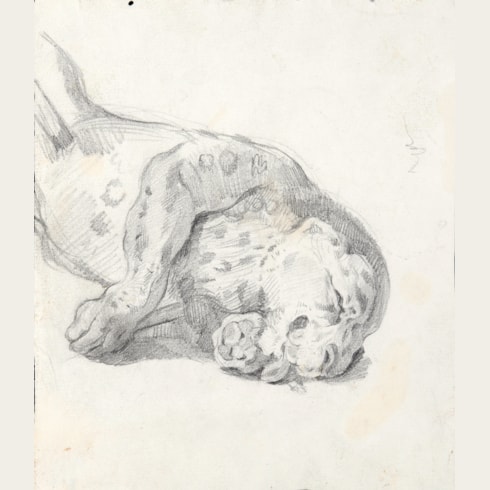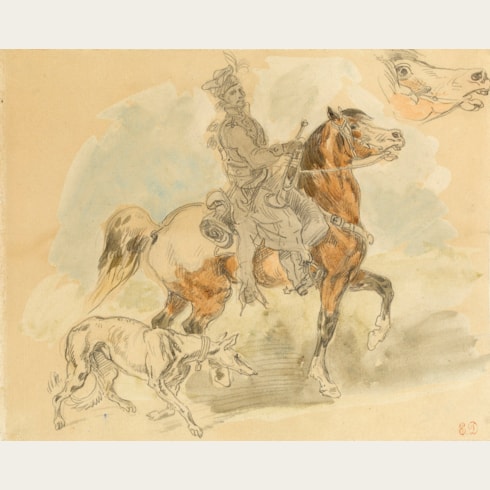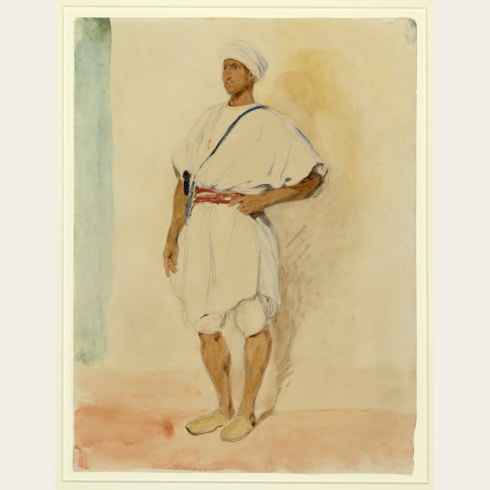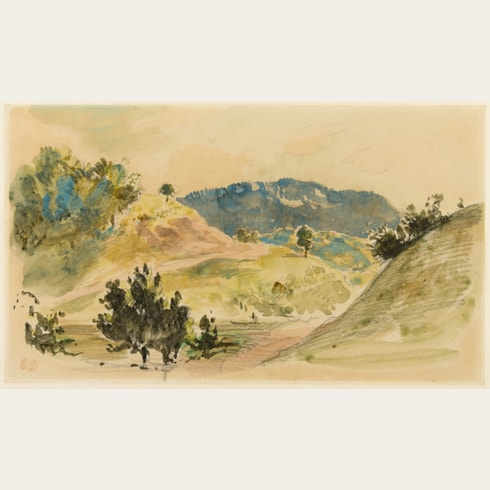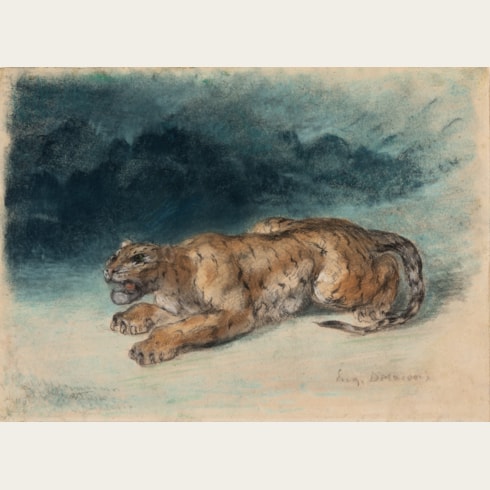Eugène DELACROIX
(Charenton-Saint Maurice 1798 - Paris 1863)
A View of a Riverbank
Sold
Watercolour over an underdrawing in pencil.
Inscribed by the artist champrosay on the verso.
213 x 329 mm. (8 3/8 x 13 in.)
Inscribed by the artist champrosay on the verso.
213 x 329 mm. (8 3/8 x 13 in.)
Eugène Delacroix produced relatively few landscape drawings, apparently because he regarded landscape as background for his paintings and not necessarily as a subject in itself. He only occasionally worked in this field, and never exhibited a landscape painting at the Salon. Although Delacroix’s use of watercolour as a medium for landscape sketches was inspired by his visit to England in 1826 and his friendship with the watercolourist Richard Parkes Bonington, it was not until the 1840’s that he regularly made landscape studies in the medium. These works were, however, never exhibited but kept in his studio until his death. Delacroix’s revived interest in landscape from the 1840’s onwards can be seen as, to some extent, the result of a series of travels he made to the mountains, the seaside and the country for the sake of his health, as well as an increasing desire for solitude and a respite from the demands made on him by his work in Paris.
The artist’s inscription ‘champrosay’ on the verso of the present sheet identifies this watercolour as a view near Delacroix’s country home at Champrosay, to the south of Paris, near Fontainebleau. Delacroix began renting the house in 1844, spending more and more time there and eventually purchasing the property in 1858, explaining his decision in a letter to his cousin; ‘But this is home: for fifteen years I’ve been coming to this region, seeing the same people, the same woods, the same hills…In other words, I bought the house…it will provide me with a small refuge in keeping with my humble fortune.’ At Champrosay, where ‘he found a veritable laboratory for the practice of landscape’, Delacroix spent much of his time sketching and drawing from nature, particularly on his daily walks in the nearby forest of Sénart and along the river Seine, just to the west of the town.
Delacroix’s watercolours, with their fluidity of wash and delicacy of touch, show that the artist, while not a specialist, could more than hold his own in this challenging medium. Such works as the present sheet are, in the words of one scholar, ‘a painter’s sketches, free from the manual and intellectual habits of the watercolor specialist and the illustrator.’
The artist’s inscription ‘champrosay’ on the verso of the present sheet identifies this watercolour as a view near Delacroix’s country home at Champrosay, to the south of Paris, near Fontainebleau. Delacroix began renting the house in 1844, spending more and more time there and eventually purchasing the property in 1858, explaining his decision in a letter to his cousin; ‘But this is home: for fifteen years I’ve been coming to this region, seeing the same people, the same woods, the same hills…In other words, I bought the house…it will provide me with a small refuge in keeping with my humble fortune.’ At Champrosay, where ‘he found a veritable laboratory for the practice of landscape’, Delacroix spent much of his time sketching and drawing from nature, particularly on his daily walks in the nearby forest of Sénart and along the river Seine, just to the west of the town.
Delacroix’s watercolours, with their fluidity of wash and delicacy of touch, show that the artist, while not a specialist, could more than hold his own in this challenging medium. Such works as the present sheet are, in the words of one scholar, ‘a painter’s sketches, free from the manual and intellectual habits of the watercolor specialist and the illustrator.’
Eugène Delacroix has long been recognized as one of the finest draughtsmen of the 19th century in France. Adept in a variety of techniques – notably pen, pencil, watercolour, charcoal and pastel - he produced a large and diverse number of drawings of all types. As a modern scholar has noted, ‘For their number, variety and importance he attached to them, drawings are an essential, if not fundamental part of Delacroix’s oeuvre…they represent the most faithful testimonies of the man and the artist with his foibles but his greatness as well.’
However, Delacroix’s output as a draughtsman remained almost completely unknown and unseen by scholars, collectors and connoisseurs until the posthumous auction of the contents of his studio held in February 1864, six months after the artist’s death, which included some six thousand drawings in 430 lots. The sale included not only preparatory compositional sketches and figure studies for Delacroix’s paintings and public commissions, but a myriad variety of drawings by the artist, including studies of wild animals, landscapes, copies after the work of earlier masters, costume studies, scenes from literature, still life subjects and the occasional portrait, as well as finished pastels. In the words of the Delacroix scholar Lee Johnson, ‘It came as a surprise to many that an artist who had been so consistently criticized throughout his career for incompetence as a draughtsman and laxity in composition was revealed by the many hundreds of graphic works, the fifty-five sketchbooks, and scores of oil sketches at his sale to have been a draughtsman of extraordinary versatility and one who went to infinite pains to elaborate the compositions of his paintings through preliminary studies of many kinds, from the inchoate scribbles of an idea in germ, to more articulate designs, to detailed drawings of pose and gesture.’
The largest single collection of drawings by Delacroix, numbering almost three thousand individual sheets and twenty-three sketchbooks, is today in the Louvre.
Provenance
The artist’s studio, Paris, with the atelier stamp (Lugt 838a) at the lower right
The Delacroix atelier sale, Paris, Hôtel Drouot, 16-29 February 1864, possibly part of lots 602 or 603
Stephen Spector, New York, in 1969
Princeton University Art Museum, Princeton, New Jersey (on loan)
Anonymous sale, New York, Christie’s, 22 May 1997, lot 39.
Literature
Michael Clarke, Poussin to Seurat: French Drawings from the National Gallery of Scotland, exhibition catalogue, London and Edinburgh, 2010-2011, p.48, under no.19.
Exhibition
New York, The New York Cultural Center; Jerusalem, The Israel Museum, Master Drawings: The Stephen Spector Collection, 1969, no.33.





